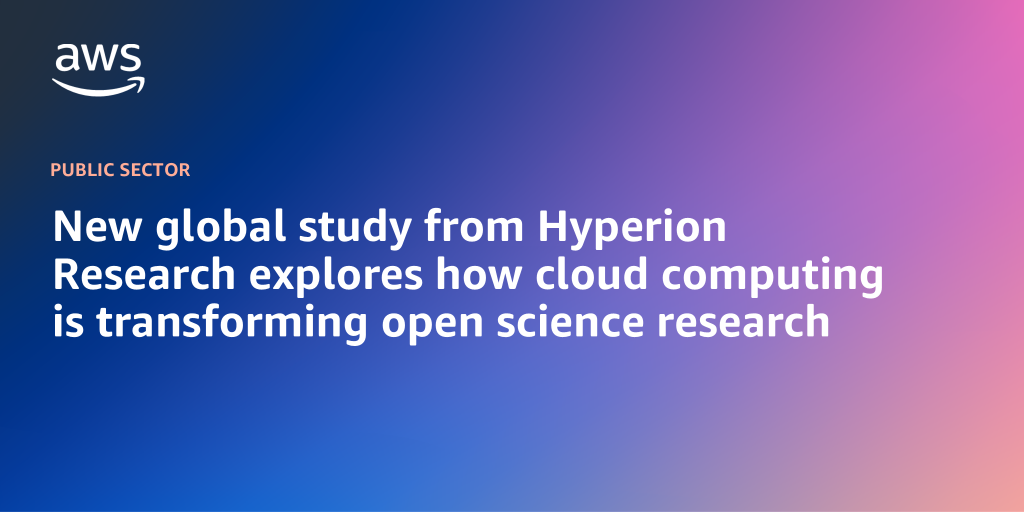AWS Public Sector Blog
Tag: compute
New global study from Hyperion Research explores how cloud computing is transforming open science research
In an era where scientific discovery transcends borders, cloud computing is helping advance how researchers collaborate and innovate across the globe. Now available for download, The Value of Utilizing Cloud Service Providers for Open Science Research report—produced by Hyperion Research and sponsored by AWS— explores how and why researchers use cloud to accelerate open science research. Read this post to learn more.
Enhancing resource sharing with AWS Outposts
In this post, we explore how AWS services, open source software, and bespoke source code can help address resource sharing enhancements requested by public sector customers using AWS Outposts. This solution aims to provide greater flexibility, control, and cost management for organizations leveraging Outposts in multi-account environments, specifically focusing on key AWS resources, including Amazon Elastic Compute Cloud (Amazon EC2), Amazon Elastic Block Store (Amazon EBS), and Amazon Simple Storage Service (Amazon S3) on Outposts.
5 best practices for accelerating research computing with AWS
Amazon Web Services (AWS) works with higher education institutions, research labs, and researchers around the world to offer cost-effective, scalable, and secure compute, storage, and database capabilities to accelerate time to science. In our work with research leaders and stakeholders, users often ask us about best practices for leveraging cloud for research. In this post, we dive into five common questions we field from research leaders as they build the academic research innovation centers of the future.
St. Louis University uses AWS to make big data accessible for researchers
The research team at SLU’s Sinquefield Center for Applied Economic Research (SCAER) required vast quantities of anonymized cell phone data in order to study the impacts of large-scale social problems. SCAER needed to store, clean, and process 450 terabytes of data, so it worked with Amazon Web Services (AWS) to create a fast, cost-effective solution for managing its growing quantities of data.
Building hybrid satellite imagery processing pipelines in AWS
In this blog post, learn how companies operating in AWS can design architectures that maximize flexibility so they can support both cloud and on-premises deployment use cases for their satellite imagery processing workloads with minimal modifications.
Data is helping EdTechs shape the next generation of solutions
Forrester estimates that data-driven businesses are growing at an average of more than 30 percent annually. This is also happening at education technology companies. With new data sources have emerging, including real-time streaming data from virtual classrooms, mobile engagement, unique usage, and new learners, these data sources are shaping the next generation of EdTech products that engage learners meaningfully around the world. Learn how four AWS EdStart Members are utilizing data to power their solutions.
How to set up Galaxy for research on AWS using Amazon Lightsail
Galaxy is a scientific workflow, data integration, and digital preservation platform that aims to make computational biology accessible to research scientists that do not have computer programming or systems administration experience. Although it was initially developed for genomics research, it is largely domain agnostic and is now used as a general bioinformatics workflow management system, running on everything from academic mainframes to personal computers. But researchers and organizations may worry about capacity and the accessibility of compute power for those with limited or restrictive budgets. In this blog post, we explain how to implement Galaxy on the cloud at a predictable cost within your research or grant budget with Amazon Lightsail.
How to deploy HL7-based provider notifications on AWS Cloud
Electronic notifications of patient events are a vital mechanism for care providers to improve care coordination and promote appropriate follow-up care in a timely manner. This post shows how a combination of Amazon Web Services (AWS) technologies, like AWS Lambda, Amazon Comprehend Medical, and AWS Fargate, can effectively manage and deliver actionable data to help healthcare customers deliver electronic notifications in a secure and efficient way.
Analyze terabyte-scale geospatial datasets with Dask and Jupyter on AWS
Terabytes of Earth Observation (EO) data are collected each day, quickly leading to petabyte-scale datasets. By bringing these datasets to the cloud, users can use the compute and analytics resources of the cloud to reliably scale with growing needs. In this post, we show you how to set up a Pangeo solution with Kubernetes, Dask, and Jupyter notebooks step-by-step on Amazon Web Services (AWS), to automatically scale cloud compute resources and parallelize workloads across multiple Dask worker nodes.
Modeling clouds in the cloud for air pollution planning: 3 tips from LADCO on using HPC
In the spring of 2019, environmental modelers at the Lake Michigan Air Directors Consortium (LADCO) had a new problem to solve. Emerging research on air pollution along the shores of the Great Lakes in the United States showed that to properly simulate the pollution episodes in the region we needed to apply our models at a finer spatial granularity than the computational capacity of our in-house HPC cluster could handle. The LADCO modelers turned to AWS ParallelCluster to access the HPC resources needed to do this modeling faster and scale for our member states.









